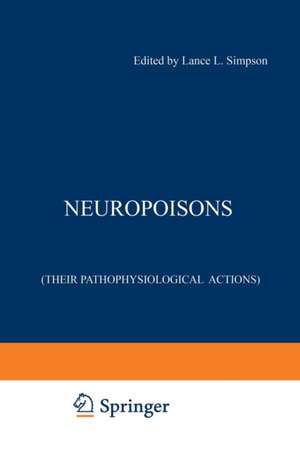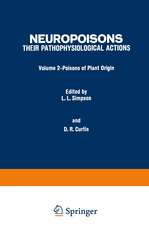Neuropoisons: Their Pathophysiological Actions
Editat de Lance L. Simpsonen Limba Engleză Paperback – 17 mar 2012
Preț: 369.65 lei
Preț vechi: 389.11 lei
-5% Nou
Puncte Express: 554
Preț estimativ în valută:
70.76€ • 72.94$ • 59.66£
70.76€ • 72.94$ • 59.66£
Carte tipărită la comandă
Livrare economică 27 februarie-13 martie
Preluare comenzi: 021 569.72.76
Specificații
ISBN-13: 9781468429428
ISBN-10: 1468429426
Pagini: 380
Ilustrații: XIV, 362 p.
Dimensiuni: 152 x 229 x 20 mm
Greutate: 0.51 kg
Ediția:1971
Editura: Springer Us
Colecția Springer
Locul publicării:New York, NY, United States
ISBN-10: 1468429426
Pagini: 380
Ilustrații: XIV, 362 p.
Dimensiuni: 152 x 229 x 20 mm
Greutate: 0.51 kg
Ediția:1971
Editura: Springer Us
Colecția Springer
Locul publicării:New York, NY, United States
Public țintă
ResearchCuprins
1 Clinical Aspects of Elapid Bite.- I. Introduction.- II. Elapidae.- III. Symptomatology of Elapid Bite.- IV. Treatment.- V. References.- 2 Mode of Action of Cobra Venom and Its Purified Toxins.- I. Introduction.- II. Chemistry of Cobra Venom.- III. Pharmacological Actions of Cobra Venom.- IV. Concluding Remarks.- V. References.- 3 Symptomatology of Experimental and Clinical Crotalid Envenomation.- I. The Rattlesnake.- II. Rattlesnake Venom Potency.- III. Physiological Effects of Venom.- IV. Treatment of Snake Bite.- V. Concluding Remarks.- VI. References.- 4 The Mechanism of Snake Venom Actions—Rattlesnakes and Other Crotalids.- I. Introduction.- II. Action of Snake Venoms.- III. References.- 5 The Use of Snake Venoms as Pharmacological Tools in Studying Nerve Activity.- I. Introduction.- II. Development and Differentiation of the Nervous System.- III. Neuronal Degeneration and Demyelination.- IV. Axonal Conduction.- V. Membrane Permeability.- VI. Phospholipid Function in Nerve.- VII. Neuronal Metabolism.- VIII. Conclusions.- IX. References.- 6 Fugu (PufFer-Fish) Poisoning and the Pharmacology of Crystalline Tetrodotoxin in Poisoning.- I. Introduction.- II. Actual Conditions and Statistical Survey of Fugu Poisoning.- III. Clinical Symptoms and Treatment of Fugu Intoxication.- IV. Pharmacological Actions Underlying Clinical Symptons.- V. Legislative Control for Preventing Fugu Poisoning in Japan.- VI. Tested Clinical Use of Crystalline Tetrodotoxin.- VII. References.- 7 Paralytic Shellfish Poisoning and Saxitoxin.- I. Occurrence and Distribution of Paralytic Shellfish Poisoning.- II. Shellfish Poisoning as a Public Health Problem.- III. Detection of Shellfish Poisoning.- IV. Isolation and Characterization of Shellfish Poisons.- V. References.- 8 Mechanism of Action ofTetrodotoxin (TTX) and Saxitoxin (STX).- I. Introduction.- II. The Nature of the Nerve Impulse.- III. Cellular Actions of TTX and STX.- IV. Comparison of TTX and STX.- V. Mechanism of Action.- VI. Conclusion.- VII. References.- 9 Tetrodotoxin and Saxitoxin as Pharmacological Tools.- I. Introduction.- II. Cellular Effects.- III. Pharmacological Uses.- IV. Conclusion.- V. References.- 10 The Clinical Effects of Tetanus.- I. Tetanus: The World Problem.- II. Clinical Features.- III. The Natural History of Tetanus.- IV. Complications.- V. Causes of Death.- VI. Treatment.- VII. Prevention of Tetanus.- VIII. References.- 11 Biochemical and Physiological Aspects of Tetanus Intoxication.- I. Introduction.- II. The Toxin.- III. Biochemical Mechanisms Involved in Tetanus Intoxication.- IV. Effect of Environmental Temperature on Tetanus Intoxication.- V. Binding of Tetanus Toxin.- VI. Physiology of Tetanus Intoxication.- VII. Summary.- VIII. References.- 12 Tetanus Toxin as a Neuropharmacological Tool.- I. Introduction.- II. Techniques of Administration.- III. Tetanus Toxin and Central Inhibition.- IV. Tetanus Toxin and Cholinergic Transmission.- V. Mode of Action.- VI. Conclusion.- VII. References.- 13 The Clinical Aspects of Botulism.- I. History.- II. Botulism as a World Health Problem.- III. Epidemiologic Considerations.- IV. Pathogenesis.- V. Clinical Features of Botulism.- VI. Diagnosis.- VII. Treatment.- VIII. Prognosis and Recovery.- IX. Remaining Problems.- X. References.- 14 The Neuroparalytic and Hemagglutinating Activities of Botulinum Toxin.- I. Introduction.- II. Characterization of the Botulinum Toxin Molecule.- III. Botulinum Hemagglutinin.- IV. Target Organs of Botulinum Neurotoxin.- V. Mechanism of Neurotoxin Action.- VI. Reactive Sites Involved in Neurotoxin Activity.- VII. Conclusion.- VIII. References.- 15 Botulinum Toxin as a Tool for Research on the Nervous System.- I. Introduction.- II. Neuromuscular Transmission.- III. Botulinum Toxin as a Pharmacological Tool.- IV. The “Trophic” Effects of Nerves.- V. Botulinum Toxin and the Autonomic Nervous System.- VI. Botulinum Toxin as a Marker of Cholinergic Synapses: A Possible Future Use.- VII. The Role of Movement in the Development of Joints: A Model System.- VIII. References.- IX. Appendix.


